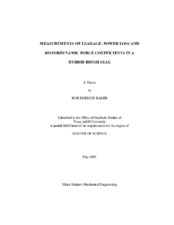| dc.description.abstract | This thesis presents measurements of power loss and leakage in a hybrid brush seal
(HBS) for increasing pressure differentials and over a range of rotor speeds. The test
HBS, Haynes-25 bristle pack [~850 bristles/cm] and 45o lay angle, is 166.4 mm in
diameter and integrates 20-arcuate pads connected with thin EDM-webs to the seal
casing.
The measured drag power at low rotor speeds (< 11 m/s at 1,300 rpm) decreases as
the pressure differential across the seal increases. At a fixed rotor speed, a significant
drop in drag torque (and drag power) ensues as the supply pressure increases, thus
demonstrating a gas film separates the rotor from the seal pads. A constant operating
temperature (~24oC) at the rotor/seal interface during tests with shaft rotation also
indicates the absence of intermittent contact between the seal pads and rotor.
Flow rate measurements at room temperature (25oC) show an improved sealing
ability with a leakage reduction of about 36%, when compared to a 1st generation shoedbrush
seal. The HBS predicted effective clearance (~50 μm) is a small fraction of that in
an equivalent one-tooth labyrinth seal.
Identified HBS direct stiffness coefficients decrease (~15%) as function of rotor
speed for an increasing supply pressure condition (Pr = 1.7 and 2.4). The identified
cross-coupled stiffness is at least one or two orders of magnitude smaller than the direct
stiffness coefficient. The cross-coupled mass is negligible for all tested rotor speeds and
supply pressures. The HBS energy dissipation mechanism is characterized in terms of a
loss factor ( γ) and dry friction coefficient ( μ). The direct HBS viscous damping coefficient is strongly dependent on the excitation frequency, while showing minimal
dependence on rotor speed or supply pressure.
The HBS novel configuration incorporates pads contacting on assembly the shaft;
and which under rotor spinning; lift off due to the generation of a hydrodynamic
pressure. Experimental results obtained show that hybrid brush seals (HBS) are a viable
alternative to overcoming the major drawbacks of labyrinth seals; namely excessive
leakage and potential for rotordynamic instability. Additionally, during operation a gas
film in HBS eliminates rotor and bristle wear, as well as thermal distortions; which are
commonly known limitations of conventional brush seals. | en |


